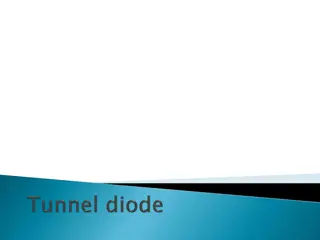Understanding PN Junction in Semiconductors
Mobility in semiconductors is affected by scattering events as temperature increases, with impurity scattering dominating at low temperatures and lattice scattering at high temperatures. A p-n junction is the interface between p-type and n-type semiconductor materials, with excess holes on the p-side and excess electrons on the n-side. Various phenomena like diffusion, formation of space charge, and drift occur during the formation of a pn junction, influencing electron and hole movement.
Download Presentation

Please find below an Image/Link to download the presentation.
The content on the website is provided AS IS for your information and personal use only. It may not be sold, licensed, or shared on other websites without obtaining consent from the author. Download presentation by click this link. If you encounter any issues during the download, it is possible that the publisher has removed the file from their server.
E N D
Presentation Transcript
Lecture 13 PN Junction
Recap Mobility is a measure of the ability of an electron or a hole to get around inside a semiconductor. Scattering events lower mobility. As the temperature of a semiconductor increases, there will be more and more lattice vibrations. Lattice vibrations create localized, microscopic potentials that can change the direction of an electron. They create scattering events. They lower mobility. Raising the temperature of a semiconductor decreases the mobility. At low temperatures dominant scattering mechanism is impurity scattering and at high temperature dominant scattering mechanism is lattice scattering.
P N Junction A p-n junction is an interface or a boundary between two semiconductor material types, namely the p-type and the n-type, inside a semiconductor. The p-side or the positive side of the semiconductor has an excess of holes and the n-side or the negative side has an excess of electrons.
Formation of pn junction Three important phenomena occurs during formation of pn junction; as explained below. 1)Diffusion 2) Formation of space charge 3) Drift
Diffusion When a junction is formed in a silicon wafer by doping, a concentration gradient occurs between p-type and n-type materials. This results in electrons moving from n side to p side and holes moving from p side to n side through the junction (call it as initial movement ). When an electron leaves the n-side region, it leaves behind an ionised donor (a positive charge ) at the n-side. Similarly when a hole is diffused to n-side, it leaves behind an ionised acceptor (a negative charge) at the p-side. This movement of electrons from n-side to p-side (n>p) and the movement of holes from p-side to n-side is called (p>n) diffusion and it results in a current named as diffusion current .
Formation of space charge We have seen that an electron moving from n to p (n>p) leaves behind a positive charge at the n-side of the junction. Similarly a hole moving from p-side to n-side (p>n) leaves behind a negative charge at the p-side of the junction. When more and more electrons leaves the n-region & more and more holes leaves the p-region, a region of positive and negative charges is formed at the junction. Positive charges get accumulated near the n-side junction and negative charges get accumulated near the p-side junction. This region is known as depletion region.
Depletion region It has been named so because the region is formed by the initial movement of electrons and holes, where they depleted their original positions leaving behind +ve and -ve charges at the junction Depletion region or depletion layer is a region in a P-N junction diode where no mobile charge carriers are present. Depletion layer acts like a barrier that opposes the flow of electrons from n-side and holes from p-side Depletion region is a region near the boundary of a p-n junction region. Atoms in the depletion region are depleted of (majority) charge carriers and are ionized.
Drift There is a layer of -ve charges accumulated at the p-side of junction and a layer of +ve charges accumulated at the n-side of the junction. This results in the formation of an electric field directed from positive charge to negative charge. This electric field causes electrons to move from p side to n side (p >n) and the holes to move from n side to p side (n >p). This motion of charge carriers due to electric field is known as drift The current resulting from the flow of electrons and holes due to this electric field (generated by depletion region) is known as driftcurrent . Drift current is opposite in direction to the diffusion current. Both the processes of drift and diffusion occur in the depletion region in opposite directions.
Diffusion and Drift Force pn junction animated diagram of equilibriumd A concentration gradient occurs when concentration of particles is higher in one area than another. the Diffusion of charge carriers across the junction in p-n junction diode occurs due to the difference in concentration of charge carriers on both sides (i.e. p and n side) of the junction.
The formation of PN Junction It is because of the diffusion of charge carriers across the junction, there forms a depletion region at the junction. And the depletion region results in formation of an electricfield and this electric field results in drift . So initially diffusioncurrent will be the highest and drift current will be very small. Gradually as the depletionregion formation continues, drift current builds up and diffusion current falls down. There comes a particular point of time, when diffusion current is exactly equal and opposite to drift current and the junction comes to a state of equilibrium. At this state, there is no netcurrent and hence the formation of pn junction is complete.
Summary Three important phenomena occurs during formation of pn junction: Diffusion, Formation of Space charge and Drift. Movement of electrons from n-side to p-side (n>p) and the movement of holes from p-side to n-side is called (p>n) diffusion. Positive charges get accumulated near the n-side junction and negative charges get accumulated near the p-side junction. This region is known as depletion region. The current resulting from the flow of electrons and holes due to this electric field (generated by depletion region) is known as driftcurrent . When diffusion current is exactly equal and opposite to drift current and the junction comes to a state of equilibrium. Or In a p-n junction both drift and diffusion occurs. In an unbiased p-n junction, drift current is equal and opposite to the diffusion current and hence net current is zero














